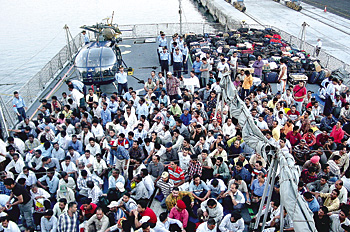INDIAN ARMED FORCES CHIEFS ON OUR RELENTLESS AND FOCUSED PUBLISHING EFFORTS

The insightful articles, inspiring narrations and analytical perspectives presented by the Editorial Team, establish an alluring connect with the reader. My compliments and best wishes to SP Guide Publications.

"Over the past 60 years, the growth of SP Guide Publications has mirrored the rising stature of Indian Navy. Its well-researched and informative magazines on Defence and Aerospace sector have served to shape an educated opinion of our military personnel, policy makers and the public alike. I wish SP's Publication team continued success, fair winds and following seas in all future endeavour!"

Since, its inception in 1964, SP Guide Publications has consistently demonstrated commitment to high-quality journalism in the aerospace and defence sectors, earning a well-deserved reputation as Asia's largest media house in this domain. I wish SP Guide Publications continued success in its pursuit of excellence.
- MoD initiates comprehensive review of Defence Acquisition Procedure 2020, pushes for defence reforms
- G7: The Swansong
- Kalinga Connect: South Asia to Polynesia
- Advanced MRSAM for India for a greater firepower
- Must Credit DRDO for Operation Sindoor, now what is next for defence R&D?
- Operation Sindoor | Day 2 DGMOs Briefing
- Operation Sindoor: Resolute yet Restrained
Evacuation
Evacuating Nationals via Sea

All through the recent history, navies have been used by different countries for combatant and non-combatant evacuation operations, from the crisis-afflicted areas
Indian Naval ships Jalashwa and Mysore set sail on February 26, 2011, to evacuate Indians stranded in Libya. INS Jalashwa, a landing platform dock type of amphibious platform designed for sea lift missions, is also capable of undertaking humanitarian missions. INS Mysore is a potent destroyer of the Delhi class. The ships have been specially equipped for the task with full medical facilities such as operation theatre, doctors and paramedics. The ships are also carrying helicopters and a contingent of marine Special Forces personnel.
Navies across the world have been employed for evacuation operations on numerous occasions. The evacuation could consist of military or civilian personnel, who would need to be evacuated for their safety, in view of the fast deteriorating military or security situation ashore.
It may be recalled that in July 2006, during operation Sukoon, the Indian Navy had similarly evacuated over 2,500 Indians, persons of Indian origin (PIO) and some foreign nationals from Lebanon following the war between Israel and the Hezbollah.
Operation Sukoon
In 2006, operation Sukoon was launched by India to evacuate Indians, nationals of Sri Lanka and Nepal, Lebanese nationals with Indian spouses, who were fleeing from the 2006 Lebanon war. Sukoon means relief in Urdu. It was the first part of a two part sea-air bridge, the sea-bridge was performed by the Indian Navy and the air-bridge by Air India.
Hezbollah and Israel went to war in July-August 2006. Hezbollah launched a cross-border raid into Israel in which 10 Israeli soldiers were killed and two of the soldiers were captured to be used to bargain for the release of Lebanese prisoners in Israel. Israel responded with an aerial and maritime blockade and a massive bombing campaign and ground invasion of Lebanon. During the war, numerous foreign nationals visiting Lebanon were caught up in the conflict. One Indian citizen was killed and three wounded on July 21 in an Israeli bombing attack.
At that point in time, four Indian navy warships were returning to India from the Mediterranean after a goodwill visit. They were ordered to return back just before they were about to negotiate the Suez Canal to assist in the evacuation. The ships were INS Mumbai, INS Brahmaputra, INS Betwa and the fleet tanker INS Shakti. This has been touted as the largest post-independence civilian-evacuation operation by the Navy.
From Lebanon, the ships took the evacuees to Cyprus from where chartered air India flights formed the second part of the air-sea bridge to fly them back to India. Altogether, a total of 2,280 people including 1,764 Indians were evacuated. Of the evacuees, 112 were Sri Lankans, 64 were Nepalis and seven were Lebanese with Indian spouses.
INS Mumbai collected 1,495 of the total evacuees, during three sorties on July 20, 23 and 26. The remaining evacuees were picked-up by the frigates INS Brahmaputra and INS Betwa (188 and 254 people respectively), during a sortie carried out on July 23. INS Shakti, being a tanker and unarmed, had not been deployed for the evacuation sorties, since it was more vulnerable and less manoeuvrable, but it was carrying enough fuel and supplies to maintain the other ships for at least a month.
PLA (Navy)
In response to the Libyan crisis, China has sent one of its most modern warships to protect vessels extracting thousands of its citizens from Libya, in the PLA (Navy)’s first naval operation in the Mediterranean sea and its first deployment of military hardware in a civilian evacuation mission. The PLA (Navy) diverted the Xuzhou, a 4,000-tonne missile frigate, from anti-piracy patrols off the coast of Somalia and dispatched it to the Libyan coast.





